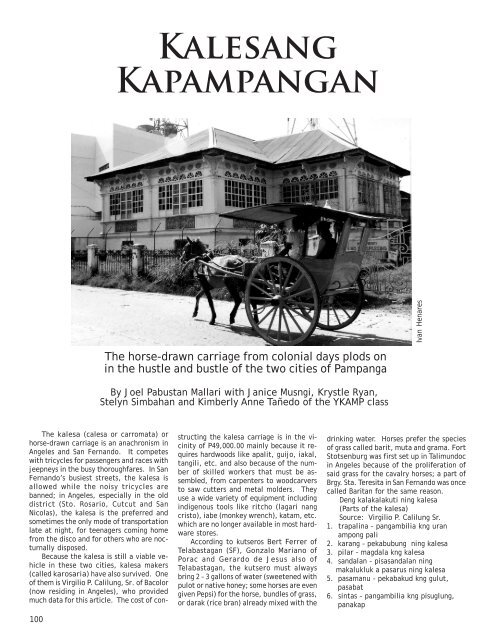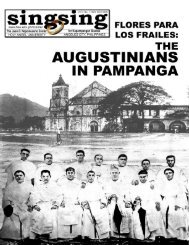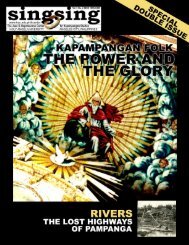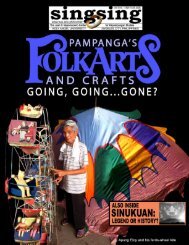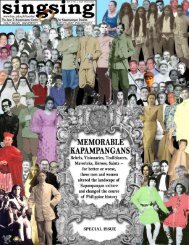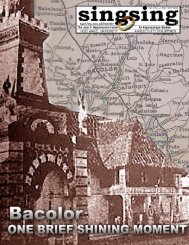Download PDF - Holy Angel University
Download PDF - Holy Angel University
Download PDF - Holy Angel University
Create successful ePaper yourself
Turn your PDF publications into a flip-book with our unique Google optimized e-Paper software.
The kalesa (calesa or carromata) or<br />
horse-drawn carriage is an anachronism in<br />
<strong>Angel</strong>es and San Fernando. It competes<br />
with tricycles for passengers and races with<br />
jeepneys in the busy thoroughfares. In San<br />
Fernando’s busiest streets, the kalesa is<br />
allowed while the noisy tricycles are<br />
banned; in <strong>Angel</strong>es, especially in the old<br />
district (Sto. Rosario, Cutcut and San<br />
Nicolas), the kalesa is the preferred and<br />
sometimes the only mode of transportation<br />
late at night, for teenagers coming home<br />
from the disco and for others who are nocturnally<br />
disposed.<br />
Because the kalesa is still a viable vehicle<br />
in these two cities, kalesa makers<br />
(called karosaria) have also survived. One<br />
of them is Virgilio P. Calilung, Sr. of Bacolor<br />
(now residing in <strong>Angel</strong>es), who provided<br />
much data for this article. The cost of con-<br />
100<br />
Kalesang<br />
Kapampangan<br />
The horse-drawn carriage from colonial days plods on<br />
in the hustle and bustle of the two cities of Pampanga<br />
By Joel Pabustan Mallari with Janice Musngi, Krystle Ryan,<br />
Stelyn Simbahan and Kimberly Anne Tañedo of the YKAMP class<br />
structing the kalesa carriage is in the vicinity<br />
of P49,000.00 mainly because it requires<br />
hardwoods like apalit, guijo, iakal,<br />
tangili, etc. and also because of the number<br />
of skilled workers that must be assembled,<br />
from carpenters to woodcarvers<br />
to saw cutters and metal molders. They<br />
use a wide variety of equipment including<br />
indigenous tools like ritcho (lagari nang<br />
cristo), iabe (monkey wrench), katam, etc.<br />
which are no longer available in most hardware<br />
stores.<br />
According to kutseros Bert Ferrer of<br />
Telabastagan (SF), Gonzalo Mariano of<br />
Porac and Gerardo de Jesus also of<br />
Telabastagan, the kutsero must always<br />
bring 2 – 3 gallons of water (sweetened with<br />
pulot or native honey; some horses are even<br />
given Pepsi) for the horse, bundles of grass,<br />
or darak (rice bran) already mixed with the<br />
Ivan Henares<br />
drinking water. Horses prefer the species<br />
of grass called barit, muta and grama. Fort<br />
Stotsenburg was first set up in Talimundoc<br />
in <strong>Angel</strong>es because of the proliferation of<br />
said grass for the cavalry horses; a part of<br />
Brgy. Sta. Teresita in San Fernando was once<br />
called Baritan for the same reason.<br />
Deng kalakalakuti ning kalesa<br />
(Parts of the kalesa)<br />
Source: Virgilio P. Calilung Sr.<br />
1. trapalina – pangambilia kng uran<br />
ampong pali<br />
2. karang – pekabubung ning kalesa<br />
3. pilar – magdala kng kalesa<br />
4. sandalan – pisasandalan ning<br />
makalukluk a pasarus ning kalesa<br />
5. pasamanu – pekabakud kng gulut,<br />
pasabat<br />
6. sintas – pangambilia kng pisuglung,<br />
panakap


